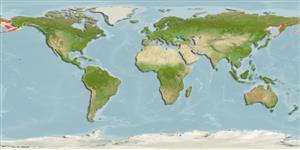Environment: milieu / climate zone / depth range / distribution range
Ecología
marino demersal; rango de profundidad 7 - 87 m (Ref. 43939). Polar
Northwest Pacific: western Bering Sea off Cape Navarin; Sea of Okhotsk and northern Sea of Japan off Tatar Strait. Northeast Pacific: northeastern Bering Sea between St. Lawrence Island and Seaward Peninsula.
Tamaño / Peso / Age
Maturity: Lm ? range ? - ? cm
Max length : 22.5 cm TL macho / no sexado; (Ref. 43939)
Short description
Claves de identificación | Morfología | Morfometría
Espinas dorsales (total) : 9 - 11; Radios blandos dorsales (total) : 15 - 16; Espinas anales: 0; Radios blandos anales: 12 - 14.
Found on sandy bottoms (Ref. 43939).
Life cycle and mating behavior
Maturities | Reproducción | Spawnings | Egg(s) | Fecundities | Larva
Mecklenburg, C.W., T.A. Mecklenburg and L.K. Thorsteinson, 2002. Fishes of Alaska. American Fisheries Society, Bethesda, Maryland. xxxvii +1037 p. (Ref. 43939)
IUCN Red List Status (Ref. 130435)
Threat to humans
Harmless
Human uses
Herramientas
Special reports
Download XML
Fuentes de Internet
Estimates based on models
Preferred temperature (Ref.
123201): -0.8 - 3.3, mean 1.6 °C (based on 196 cells).
Phylogenetic diversity index (Ref.
82804): PD
50 = 1.0000 [Uniqueness, from 0.5 = low to 2.0 = high].
Bayesian length-weight: a=0.01000 (0.00244 - 0.04107), b=3.04 (2.81 - 3.27), in cm total length, based on all LWR estimates for this body shape (Ref.
93245).
Nivel trófico (Ref.
69278): 3.5 ±0.5 se; based on size and trophs of closest relatives
Resiliencia (Ref.
120179): Medio, población duplicada en un tiempo mínimo de 1.4-4.4 años (Preliminary K or Fecundity.).
Fishing Vulnerability (Ref.
59153): Low vulnerability (13 of 100).
